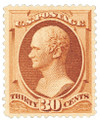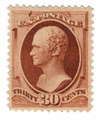
# 217 - 1888 30c Hamilton, orange brown
Series of 1888 30¢ Hamilton
Issue Date: January, 1888
Quantity issued: 710,720
Printed by: American Bank Note Company
Method: Flat plate
Watermark: None
Perforation: 12
Color: Orange brown
On April 5, 1792, George Washington used the first presidential veto in our country’s history. It was to turn down a bill that he felt unconstitutionally gave some states more members in the House of Representatives than the Constitution would allow. The US Constitution stated that the number of seats in the House of Representatives should be decided after a census of the state populations was made within three years of Congress’s first meeting. The first census was taken in 1790. According to the Constitution the appropriation of seats would be based on the population of each state, and that each state would get at least one representative. The bill stated that the total number of representatives would be 120, and that the number of representatives per state would be decided by dividing the population by 30,000. However, eight of the states that had a large fraction left over after this division each received one additional representative. The bill passed the House on February 12, 1792, and the Senate on March 12. It was then submitted to President Washington for his approval. Washington turned to his advisors for their opinions on the bill. Edmund Randolph and Thomas Jefferson believed the bill was unconstitutional. They argued against the number of representatives it established and also that the additional members added to eight states was “repugnant to the spirit of the Constitution.” Henry Knox and Alexander Hamilton supported the bill’s approval. They argued that the Constitution was unclear about “whether the numbers of representatives shall be apportioned on the aggregate number of all people in the United States, or on the aggregate numbers of the people of each state.” Washington considered both sides, but ultimately sided with Jefferson and Randolph and issued the first presidential veto in US history on April 5, 1792. In his response, Washington stated that “there is no one proportion or divisor which, applied to the respective numbers of the States will yield the number and allotment of representatives proposed by the Bill… [and] the bill has allotted to eight of the States more than one [representative] for thirty thousand.” Congress attempted to override Washington’s veto but didn’t get the two-thirds vote they needed. So, they wrote a new bill that would establish the House on “the ratio of one for every thirty-three thousand persons in the respective States.” Additionally, any fractional remainders wouldn’t add to the number of representatives for any state. The bill passed the House and Senate on April 10 and Washington signed it into law on April 14. Washington would only use his veto power one more time during his presidency. In 1797, he vetoed an act that called to reduce the number of cavalry units in the army. To date, America’s presidents have issued over 2,500 vetoes. Franklin Roosevelt had the most with 635. Seven presidents never vetoed a bill. And 112 presidential vetoes have been overridden.First Presidential Veto
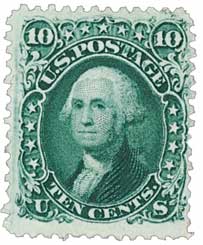
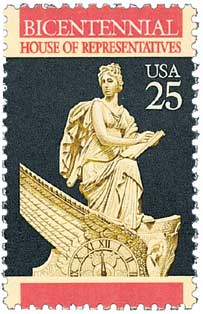
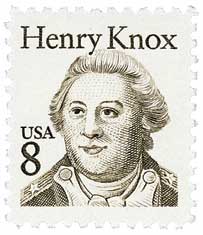
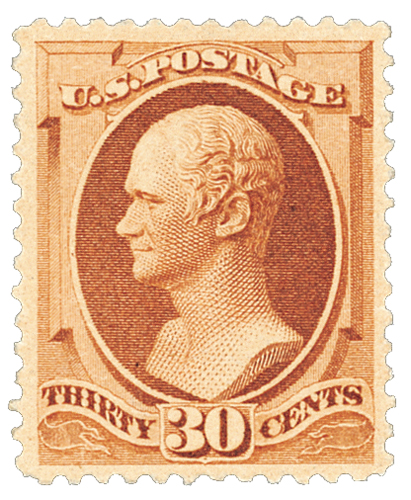
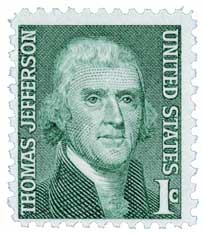
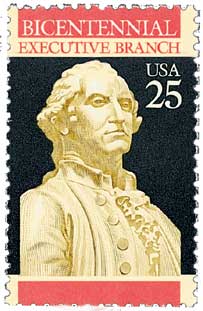
Series of 1888 30¢ Hamilton
Issue Date: January, 1888
Quantity issued: 710,720
Printed by: American Bank Note Company
Method: Flat plate
Watermark: None
Perforation: 12
Color: Orange brown
On April 5, 1792, George Washington used the first presidential veto in our country’s history. It was to turn down a bill that he felt unconstitutionally gave some states more members in the House of Representatives than the Constitution would allow. The US Constitution stated that the number of seats in the House of Representatives should be decided after a census of the state populations was made within three years of Congress’s first meeting. The first census was taken in 1790. According to the Constitution the appropriation of seats would be based on the population of each state, and that each state would get at least one representative. The bill stated that the total number of representatives would be 120, and that the number of representatives per state would be decided by dividing the population by 30,000. However, eight of the states that had a large fraction left over after this division each received one additional representative. The bill passed the House on February 12, 1792, and the Senate on March 12. It was then submitted to President Washington for his approval. Washington turned to his advisors for their opinions on the bill. Edmund Randolph and Thomas Jefferson believed the bill was unconstitutional. They argued against the number of representatives it established and also that the additional members added to eight states was “repugnant to the spirit of the Constitution.” Henry Knox and Alexander Hamilton supported the bill’s approval. They argued that the Constitution was unclear about “whether the numbers of representatives shall be apportioned on the aggregate number of all people in the United States, or on the aggregate numbers of the people of each state.” Washington considered both sides, but ultimately sided with Jefferson and Randolph and issued the first presidential veto in US history on April 5, 1792. In his response, Washington stated that “there is no one proportion or divisor which, applied to the respective numbers of the States will yield the number and allotment of representatives proposed by the Bill… [and] the bill has allotted to eight of the States more than one [representative] for thirty thousand.” Congress attempted to override Washington’s veto but didn’t get the two-thirds vote they needed. So, they wrote a new bill that would establish the House on “the ratio of one for every thirty-three thousand persons in the respective States.” Additionally, any fractional remainders wouldn’t add to the number of representatives for any state. The bill passed the House and Senate on April 10 and Washington signed it into law on April 14. Washington would only use his veto power one more time during his presidency. In 1797, he vetoed an act that called to reduce the number of cavalry units in the army. To date, America’s presidents have issued over 2,500 vetoes. Franklin Roosevelt had the most with 635. Seven presidents never vetoed a bill. And 112 presidential vetoes have been overridden.First Presidential Veto









